Indo-Greek art
| Part of a series on the |
| Indo-Greek Kingdom |
|---|
 |
The art of the Indo-Greek is poorly documented, and few works of art (apart from their coins and a few stone palettes) are directly attributed to them. The coinage of the Indo-Greeks however is generally considered as some of the most artistically brilliant of Antiquity.[1] The Hellenistic heritage (Ai-Khanoum) and artistic proficiency of the Indo-Greek would suggest a rich sculptural tradition as well, but traditionally very few sculptural remains have been attributed to them. On the contrary, most Gandharan Hellenistic works of art are usually attributed to the direct successors of the Indo-Greeks in India in the 1st century CE, such as the nomadic Indo-Scythians, the Indo-Parthians and, in an already decadent state, the Kushans[2] In general, Gandharan sculpture cannot be dated exactly, leaving the exact chronology open to interpretation.
Incipient Greco-Buddhist art
The possibility of a direct connection between the Indo-Greeks and Greco-Buddhist art has been reaffirmed recently as the dating of the rule of Indo-Greek kings has been extended to the first decades of the 1st century CE, with the reign of Strato II in the Punjab.[3] Also, Foucher, Tarn and more recently Boardman, Bussagli or McEvilley have taken the view that some of the most purely Hellenistic works of northwestern India and Afghanistan, may actually be wrongly attributed to later centuries, and instead belong to a period one or two centuries earlier, to the time of the Indo-Greeks in the 2nd-1st century BCE:[4]
This is particularly the case of some purely Hellenistic works in Hadda, Afghanistan, an area which "might indeed be the cradle of incipient Buddhist sculpture in Indo-Greek style".[5] Referring to one of the Buddha triads in Hadda (drawing), in which the Buddha is sided by very Classical depictions of Herakles/Vajrapani and Tyche/Hariti, Boardman explains that both figures "might at first (and even second) glance, pass as, say, from Asia Minor or Syria of the first or second century BC (...) these are essentially Greek figures, executed by artists fully conversant with far more than the externals of the Classical style".[6] Many of the works of art at Hadda can also be compared to the style of the 2nd century BCE sculptures of the Hellenistic world, such as those of the Temple of Olympia at Bassae in Greece, which could also suggest roughly contemporary dates.
Alternatively, it has been suggested that these works of art may have been executed by itinerant Greek artists during the time of maritime contacts with the West from the 1st to the 3rd century CE.[7]
The supposition that such highly Hellenistic and, at the same time Buddhist, works of art belong to the Indo-Greek period would be consistent with the known Buddhist activity of the Indo-Greeks (the Milinda Panha etc...), their Hellenistic cultural heritage which would naturally have induced them to produce extensive statuary, their know artistic proficiency as seen on their coins until around 50 BCE, and the dated appearance of already complex iconography incorporating Hellenistic sculptural codes with the Bimaran casket in the early 1st century CE.
Indo-Greeks in the art of Gandhara
The Greco-Buddhist art of Gandhara, beyond the omnipresence of Greek style and stylistic elements which might be simply considered as an enduring artistic tradition,[8] offers numerous depictions of people in Greek Classical realistic style, attitudes and fashion (clothes such as the chiton and the himation, similar in form and style to the 2nd century BCE Greco-Bactrian statues of Ai-Khanoum, hairstyle), holding contraptions which are characteristic of Greek culture (amphoras, "kantaros" Greek drinking cups), in situations which can range from festive (such as Bacchanalian scenes) to Buddhist-devotional.[9][10]
Uncertainties in dating make it unclear whether these works of art actually depict Greeks of the period of Indo-Greek rule up to the 1st century BCE, or remaining Greek communities under the rule of the Indo-Parthians or Kushans in the 1st and 2nd century CE.
Stone palettes
Numerous early stone palettes found in Gandhara are considered as direct productions of the Indo-Greeks during the 2nd to the 1st century BCE.[11] The art style of the palettes later evolved under the Indo-Scythians and Indo-Parthians, but production stopped with the advent of the Kushans.[12] Usually these palettes represent people in Greek dress in mythological or gallant scenes.
Hellenistic groups
A series of reliefs, several of them known as the Buner reliefs which were taken during the 19th century from Buddhist structures near the area of Buner in northern Pakistan, depict in perfect Hellenistic style gatherings of people in Greek dress, socializing, drinking or playing music.[13] Some other of these reliefs depict Indo-Scythian soldiers in uniform, sometimes playing instruments.[14] Finally, revelling Indian in dhotis richly adorned with jewelry are also shown. These are considered some of the most artistically perfect, and earliest, of Gandharan sculptures, and are thought to exalt multicultural interaction within the context of Buddhism, in the 1st century BCE or the 1st century CE.
 Hellenistic drinking scene.
Hellenistic drinking scene. Hellenistic marine deities, Gandhara, 1st century.
Hellenistic marine deities, Gandhara, 1st century. Hellenistic drinking scene, Sar Khi Derri.
Hellenistic drinking scene, Sar Khi Derri.
Bacchic scenes
Greeks harvesting grapes, Greeks drinking and revelling, scenes of erotical courtship are also numerous, and seem to relate to some of the most remarkable traits of Greek culture.[15] These reliefs also belong to Buddhist structures, and it is sometimes suggested that they might represent some kind of paradisical world after death.
- Bacchanalian scene, representing the harvest of wine grapes, Greco-Buddhist art of Gandhara, 1st-2nd century CE.
 Indo-Greek bacchanalian scene, 1st-2nd century.
Indo-Greek bacchanalian scene, 1st-2nd century. Satyr on a mountain goat, drinking with women. Gandhara, 2nd-4th century.
Satyr on a mountain goat, drinking with women. Gandhara, 2nd-4th century. Bacchic erotical scene with standing Buddha. Butkara, Swat, Gandhara.
Bacchic erotical scene with standing Buddha. Butkara, Swat, Gandhara. Musician wearing the chiton dress.
Musician wearing the chiton dress. Bacchanalian scene, Gandhara.
Bacchanalian scene, Gandhara.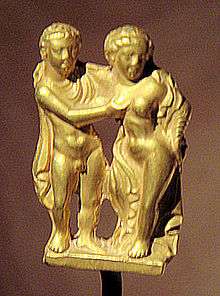 Hellenistic couple from Taxila (IV).
Hellenistic couple from Taxila (IV).
Hellenistic devotees

Depictions of people in Hellenistic dress within a Buddhist context are also numerous.[16] Some show a Greek devotee couple circambulating stupas together with shaven monks, others Greek protagonists are incorporated in Buddhist jataka stories of the life of the Buddha (relief of The Great Departure), others are simply depicted as devotees on the columns of Buddhist structures. A few famous friezes, including one in the British Museum, also depict the story of the Trojan horse. It is unclear whether these reliefs actually depict contemporary Greek devotees in the area of Gandhara, or if they are just part of a remaining artistic tradition. Most of these reliefs are usually dated to the 1st-3rd century CE.
 Couple of devotees in Hellenistic himation dress, at the base of a Buddha statue.
Couple of devotees in Hellenistic himation dress, at the base of a Buddha statue. Devotee in Greek dress, on a Buddhist pilaster. Chakhil-i-Ghoundi Stupa.
Devotee in Greek dress, on a Buddhist pilaster. Chakhil-i-Ghoundi Stupa.- "The Great Departure", with the Buddha amid Greek deities and costumes.
- Hellenistic man or God, Gandhara.
 Indo-Corinthian capital representing a Buddhist devotee wearing a Greek cloak (chlamys) attached by a fibula. Dated to the 1st century BCE. Butkara Stupa.
Indo-Corinthian capital representing a Buddhist devotee wearing a Greek cloak (chlamys) attached by a fibula. Dated to the 1st century BCE. Butkara Stupa.
See also
- Greco-Bactrian Kingdom
- Seleucid Empire
- Greco-Buddhism
- Indo-Scythians
- Indo-Parthian Kingdom
- Kushan Empire
- Roman commerce
- Timeline of Indo-Greek Kingdoms
Notes
- ↑ "The extraordinary realism of their portraiture. The portraits of Demetrius, Antimachus and of Eucratides are among the most remarkable that have come down to us from antiquity" Hellenism in ancient India, Banerjee, p134
- ↑ "Just as the Frank Clovis had no part in the development of Gallo-Roman art, the Indo-Scythian Kanishka had no direct influence on that of Indo-Greek Art; and besides, we have now the certain proofs that during his reign this art was already stereotyped, of not decadent" Hellenism in Ancient India, Banerjee, p147
- ↑ "The survival into the 1st century AD of a Greek administration and presumably some elements of Greek culture in the Punjab has now to be taken into account in any discussion of the role of Greek influence in the development of Gandharan sculpture", The Crossroads of Asia, p. 14
- ↑ On the Indo-Greeks and the Gandhara school:
- 1) "It is necessary to considerably push back the start of Gandharan art, to the first half of the first century BCE, or even, very probably, to the preceding century.(...) The origins of Gandharan art... go back to the Greek presence. (...) Gandharan iconography was already fully formed before, or at least at the very beginning of our era" Mario Bussagli "L'art du Gandhara", p331–332
- 2) "The beginnings of the Gandhara school have been dated everywhere from the first century B.C. (which was M. Foucher's view) to the Kushan period and even after it" (Tarn, p394). Foucher's views can be found in "La vieille route de l'Inde, de Bactres a Taxila", pp340–341). The view is also supported by Sir John Marshall ("The Buddhist art of Gandhara", pp5–6).
- 3) Also the recent discoveries at Ai-Khanoum confirm that "Gandharan art descended directly from Hellenized Bactrian art" (Chaibi Nustamandy, "Crossroads of Asia", 1992).
- 4) On the Indo-Greeks and Greco-Buddhist art: "It was about this time (100 BCE) that something took place which is without parallel in Hellenistic history: Greeks of themselves placed their artistic skill at the service of a foreign religion, and created for it a new form of expression in art" (Tarn, p393). "We have to look for the beginnings of Gandharan Buddhist art in the residual Indo-Greek tradition, and in the early Buddhist stone sculpture to the South (Bharhut etc.)" (Boardman, 1993, p124). "Depending on how the dates are worked out, the spread of Gandhari Buddhism to the north may have been stimulated by Menander's royal patronage, as may the development and spread of the Gandharan sculpture, which seems to have accompanied it" McEvilley, 2002, "The shape of ancient thought", p378.
- ↑ Boardman, p141
- ↑ Boardman, p143
- ↑ "Others, dating the work to the first two centuries A.D., after the waning of Greek autonomy on the Northwest, connect it instead with the Roman Imperial trade, which was just then getting a foothold at sites like Barbaricum (modern Karachi) at the Indus-mouth. It has been proposed that one of the embassies from Indian kings to Roman emperors may have brought back a master sculptorto oversee work in the emerging Mahayana Buddhist sensibility (in which the Buddha came to be seen as a kind of deity), and that "bands of foreign workmen from the eastern centers of the Roman Empire" were brought to India" (Mc Evilley "The shape of ancient thought", quoting Benjamin Rowland "The art and architecture of India" p121 and A.C. Soper "The Roman Style in Gandhara" American Journal of Archaeology 55 (1951) pp301–319)
- ↑ Boardman, p.115
- ↑ McEvilley, p.388-390
- ↑ Boardman, 109-153
- ↑ Boardman, p.116
- ↑ "Let us remind that in Sirkap, stone palettes were found at all excavated levels. On the contrary, neither Bhir-Mound, the Maurya city preceding Sirkap on the Taxila site, nor Sirsukh, the Kushan city succeeding her, did deliver any stone palettes during their excavations", in "Les palettes du Gandhara", p89. "The terminal point after which such palettes are not manufactured anymore is probably located during the Kushan period. In effect, neither Mathura nor Taxila (although the Sirsukh had only been little excavated), nor Begram, nor Surkh Kotal, neither the great Kushan archaeological sites of Soviet Central Asia or Afghanistan have yielded such objects. Only four palettes have been found in Kushan-period archaeological sites. They come from secondary sites, such as Garav Kala and Ajvadz in Soviet Tajikistan and Jhukar, in the Indus Valley, and Dalverzin Tepe. They are rather roughly made." In "Les Palettes du Gandhara", Henri-Paul Francfort, p91. (in French in the original)
- ↑ Boardman, p.126
- ↑ Marshall, "The Buddhist art of Gandhara", p.36
- ↑ "At the time, a favourite theme of Graeco-Parthian secular art was the drinking scene, and incongruous as it may seem, this was one of the earliest themes to be adopted for the decoration of Buddhist stupas." Marshall, p.33
- ↑ Marshall, p.33-39
References
- Bopearachchi, Osmund (1991). Monnaies Gréco-Bactriennes et Indo-Grecques, Catalogue Raisonné (in French). Bibliothèque Nationale de France. ISBN 2-7177-1825-7.
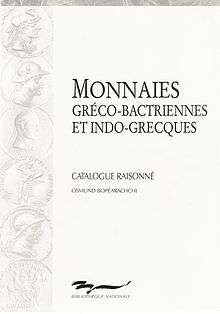
- Avari, Burjor (2007). India: The ancient past. Routledge. ISBN 0415356164.
- Faccenna, Domenico (1980). Butkara I (Swāt, Pakistan) 1956–1962, Volume III 1. Rome: IsMEO (Istituto Italiano Per Il Medio Ed Estremo Oriente).
- McEvilley, Thomas (2002). The Shape of Ancient Thought. Comparative studies in Greek and Indian Philosophies. Allworth Press and the School of Visual Arts. ISBN 1-58115-203-5.
- Puri, Baij Nath (2000). Buddhism in Central Asia. Delhi: Motilal Banarsidass. ISBN 81-208-0372-8.
- Tarn, W. W. (1984). The Greeks in Bactria and India. Chicago: Ares. ISBN 0-89005-524-6.
- A.K. Narain, A.K. (2003). The Indo-Greeks. B.R. Publishing Corporation. "revised and supplemented" from Oxford University Press edition of 1957.
- A.K. Narain, A.K. (1976). The coin types of the Indo-Greeks kings. Chicago, USA: Ares Publishing. ISBN 0-89005-109-7.
- Cambon, Pierre (2007). Afghanistan, les trésors retrouvés (in French). Musée Guimet. ISBN 9782711852185.
- Keown, Damien (2003). A Dictionary of Buddhism. New York: Oxford University Press. ISBN 0-19-860560-9.
- Bopearachchi, Osmund (2003). De l'Indus à l'Oxus, Archéologie de l'Asie Centrale (in French). Lattes: Association imago-musée de Lattes. ISBN 2-9516679-2-2.
- Boardman, John (1994). The Diffusion of Classical Art in Antiquity. Princeton, NJ: Princeton University Press. ISBN 0-691-03680-2.
- Errington, Elizabeth; Cribb, Joe; Claringbull, Maggie; Ancient India and Iran Trust; Fitzwilliam Museum (1992). The Crossroads of Asia : transformation in image and symbol in the art of ancient Afghanistan and Pakistan. Cambridge: Ancient India and Iran Trust. ISBN 0-9518399-1-8.
- Bopearachchi, Osmund; Smithsonian Institution; National Numismatic Collection (U.S.) (1993). Indo-Greek, Indo-Scythian and Indo-Parthian coins in the Smithsonian Institution. Washington: National Numismatic Collection, Smithsonian Institution. OCLC 36240864.
- 東京国立博物館 (Tokyo Kokuritsu Hakubutsukan); 兵庫県立美術館 (Hyogo Kenritsu Bijutsukan) (2003). Alexander the Great : East-West cultural contacts from Greece to Japan. Tokyo: 東京国立博物館 (Tokyo Kokuritsu Hakubutsukan). OCLC 53886263.
- Lowenstein, Tom (2002). The vision of the Buddha : Buddhism, the path to spiritual enlightenment. London: Duncan Baird. ISBN 1-903296-91-9.
- Foltz, Richard (2000). Religions of the Silk Road : overland trade and cultural exchange from antiquity to the fifteenth century. New York: St. Martin's Griffin. ISBN 0-312-23338-8.
- Marshall, Sir John Hubert (2000). The Buddhist art of Gandhara : the story of the early school, its birth, growth, and decline. New Delhi: Munshiram Manoharlal. ISBN 81-215-0967-X.
- Mitchiner, John E.; Garga (1986). The Yuga Purana : critically edited, with an English translation and a detailed introduction. Calcutta, India: Asiatic Society. ISBN 81-7236-124-6. OCLC 15211914.
- Salomon, Richard. "The "Avaca" Inscription and the Origin of the Vikrama Era". 102.
- Banerjee, Gauranga Nath (1961). Hellenism in ancient India. Delhi: Munshi Ram Manohar Lal. ISBN 0-8364-2910-9. OCLC 1837954.
- Bussagli, Mario; Tissot, Francine; Arnal, Béatrice (1996). L'art du Gandhara (in French). Paris: Librairie générale française. ISBN 2-253-13055-9.
- Marshall, John (1956). Taxila. An illustrated account of archaeological excavations carried out at Taxila (3 volumes). Delhi: Motilal Banarsidass.
- éd. par Osmund Bopearachchi ... (2005). Afghanistan, ancien carrefour entre l'est et l'ouest (in French and English). Belgium: Brepols. ISBN 2503516815.
- Seldeslachts, E. (2003). The end of the road for the Indo-Greeks?. (Also available online): Iranica Antica, Vol XXXIX, 2004.
- Senior, R.C. (2006). Indo-Scythian coins and history. Volume IV. Classical Numismatic Group, Inc. ISBN 0-9709268-6-3.
| The Indo-Greeks and Buddhism: chronological markers | ||||||||||||
| Periods/ Markers: |
MAURYA EMPIRE (315–180 BCE) |
INDO-GREEK KINGDOM (180 BCE–20 CE) |
INDO-PARTHIAN KINGDOM (20–60 CE) |
KUSHAN EMPIRE (60–240 CE) | ||||||||
| INDO-SCYTHIAN KINGDOM (80 BCE–20 CE) | ||||||||||||
| ARTIFACTS: | 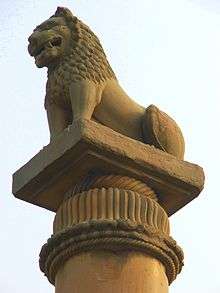 Pillars of Ashoka (c. 250 BCE) |
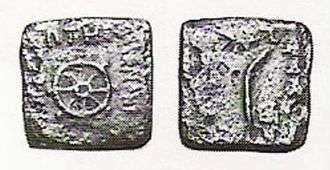 Buddhist coins of Menander I (c. 150 BCE) |
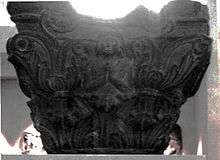 Butkara stupa pillar (20 BCE) |
Mahayana Buddhist triads | ||||||||
Bimaran casket (30 BCE–60 CE)
| ||||||||||||
| EPIGRAPHY: | Edicts of Ashoka (c. 250 BCE) |
Milinda Panha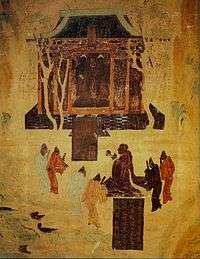 Chinese Buddhist accounts of Golden statues from Central Asia in 120 BCE |
Mathura lion capital (20 CE) |
Buddhist coinage of Kanishka, derived from free-standing Buddha statues (120 CE) | ||||||||
| BUDDHA STATUES: |
None |  Greco-Buddhist statuary (Pre-Kushan)[1] |
Kushan Buddhist friezes | |||||||||
| STUPAS: (Butkara stupa)[2] |
Simple stupas |
Improved stupas with niches for statues or friezes. |
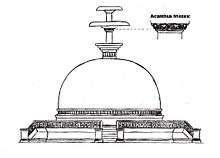 Colonated stupas |
 Stupas with narrative friezes | ||||||||
| References: | 1 In Alfred Foucher, The Beginnings of Buddhist Art, 1917. 2 Domenico Facenna, Sculptures from the Sacred Area of Butkara I, 1962, pp. 21–76. | |||||||||||
| Wikimedia Commons has media related to Art of the Indo-Greek Kingdom. |
